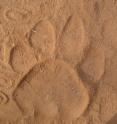Paw prints and feces offer new hope for saving tigers
As experts gather in St Petersburg, Russia for next week's Tiger Summit, fewer than 3,200 tigers survive in the wild worldwide. More than half live in India, where they are spread over a vast area (100,000 sq km) of forest. According to Dr Yadvendradev Jhala of the Wildlife Institute of India, lead author of the new study: "Tigers are cryptic, nocturnal and occur at low densities so they are extremely difficult to monitor. Unless we know how many tigers are left in the wild, and whether their numbers are increasing or decreasing, we will not be able to conserve them."
Until now, tiger numbers have been monitored either by their paw prints (known as pugmarks) or by using camera traps. Although wildlife agencies use paw prints to identify individual animals, scientists regard this as an inaccurate way of monitoring tiger numbers. And while camera trap mark-recapture is reliable, it requires highly-trained personnel and is so expensive and labour intensive that it cannot be widely used.
In search of a low-cost, scientifically-robust monitoring method, Dr Jhala and colleagues worked at 21 different sites in the forests of Central and North India collecting two tiger signs– paw prints and faeces. "Tiger faeces are the size of large beetroot and have a characteristic pungent, musky odour. Fresh tiger faeces are normally accompanied by urine sprays that smell like well-cooked basmati rice," Dr Jhala explains.
When they compared this data with that from camera traps at the same sites, they found they could estimate tiger numbers as accurately by using the two tiger signs – paw prints and faeces – as they could with camera traps, but for a fraction of the price. For each site, it cost US$1,240 and took 220 person-days to collect data on paw prints and faeces, compared with US$17,000 and 720 person-days for camera trapping.
The results have crucial implications for conserving tigers and other endangered species worldwide. "By showing that it is possible to accurately estimate tiger numbers from their paw prints and faeces, we have opened up a new way of cost-effectively keeping our finger on the pulse of tiger populations and gauging the success of conservation programmes. This approach could be applied to monitoring other endangered species across vast landscapes," Dr Jhala says.
Source: Wiley-Blackwell
Other sources
- Wild Tigers Threatened With Extinctionfrom CBSNews - ScienceSat, 27 Nov 2010, 8:30:54 UTC
- Experts Say China Fuels Tiger Poachingfrom CBSNews - ScienceSat, 27 Nov 2010, 8:30:44 UTC
- Dot Earth: Wild Tigers on a Crowding Planetfrom NY Times ScienceWed, 24 Nov 2010, 22:10:20 UTC
- Summit on tigers produces agreementfrom UPIWed, 24 Nov 2010, 22:00:38 UTC
- Summit agrees tiger recovery planfrom BBC News: Science & NatureWed, 24 Nov 2010, 11:30:26 UTC
- Illicit trade threatens Asia's tigersfrom UPIWed, 24 Nov 2010, 0:40:19 UTC
- Tigers' poop can give the scoop on their numbersfrom MSNBC: ScienceWed, 24 Nov 2010, 0:31:10 UTC
- 13 nations sign declaration meant to save tigersfrom PhysorgTue, 23 Nov 2010, 18:32:03 UTC
- Russia, China pledge to save the tigerfrom Reuters:ScienceTue, 23 Nov 2010, 18:10:50 UTC
- 'Number Two' Could Help Count Endangered Tigersfrom Live ScienceTue, 23 Nov 2010, 17:30:49 UTC
- Experts Say China Fuels Tiger Poachingfrom CBSNews - ScienceTue, 23 Nov 2010, 15:01:00 UTC
- Tigers' demise linked to organized crime: UNfrom CBC: Technology & ScienceTue, 23 Nov 2010, 14:00:40 UTC
- Experts Say China Fuels Tiger Poachingfrom CBSNews - ScienceTue, 23 Nov 2010, 7:30:56 UTC
- Wild Tigers Threatened With Extinctionfrom CBSNews - ScienceMon, 22 Nov 2010, 23:00:44 UTC
- Experts: Demand in China fuels tiger poachingfrom PhysorgMon, 22 Nov 2010, 21:32:07 UTC
- Wild Tigers Threatened With Extinctionfrom CBSNews - ScienceMon, 22 Nov 2010, 21:31:59 UTC
- Meeting Aims to Turn Tiger Fascination Into Conservationfrom NY Times ScienceMon, 22 Nov 2010, 19:40:13 UTC
- Putin Calls Meeting on Tiger Threatsfrom NY Times ScienceMon, 22 Nov 2010, 5:00:24 UTC
- Wild Tigers Threatened With Extinctionfrom CBSNews - ScienceMon, 22 Nov 2010, 0:00:26 UTC
- Tigers could be extinct in 12 years if unprotectedfrom PhysorgSun, 21 Nov 2010, 18:00:21 UTC
- Russia hosts 'tiger summit'from AP ScienceSun, 21 Nov 2010, 11:30:33 UTC
- Only 3,000 tigers left in the worldfrom BBC News: Science & NatureSun, 21 Nov 2010, 11:30:31 UTC
- World leaders seek to save the tiger from extinctionfrom PhysorgSun, 21 Nov 2010, 11:30:29 UTC
- Tiger talks aim to double numbersfrom BBC News: Science & NatureSun, 21 Nov 2010, 10:00:34 UTC
- Summit to discuss saving tigersfrom UPISat, 20 Nov 2010, 22:50:17 UTC
- Poo and paws help in tiger countfrom BBC News: Science & NatureSat, 20 Nov 2010, 21:00:23 UTC
- ‘Last Chance for the Tiger,’ Says World Bank Presidentfrom Live ScienceSat, 20 Nov 2010, 20:30:34 UTC
- India using low-tech tiger monitoringfrom UPISat, 20 Nov 2010, 0:30:27 UTC
- Paw prints and feces offer new hope for saving tigersfrom PhysorgFri, 19 Nov 2010, 10:20:57 UTC
- Paw prints and feces offer new hope for saving tigersfrom Science DailyFri, 19 Nov 2010, 4:20:32 UTC
- World's Space Agency Leaders Discuss Common Goals at Summitfrom Space.comThu, 18 Nov 2010, 13:50:22 UTC
- Tiger Summit: What Will It Take to Save Iconic Cat?from Live ScienceTue, 16 Nov 2010, 21:10:31 UTC


